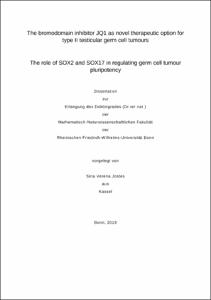The bromodomain inhibitor JQ1 as novel therapeutic option for type II testicular germ cell tumours [and] The role of SOX2 and SOX17 in regulating germ cell tumour pluripotency

The bromodomain inhibitor JQ1 as novel therapeutic option for type II testicular germ cell tumours [and] The role of SOX2 and SOX17 in regulating germ cell tumour pluripotency

| dc.contributor.advisor | Schorle, Hubert | |
| dc.contributor.author | Jostes, Sina Verena | |
| dc.date.accessioned | 2020-04-26T22:07:20Z | |
| dc.date.available | 2020-04-26T22:07:20Z | |
| dc.date.issued | 01.08.2019 | |
| dc.identifier.uri | https://hdl.handle.net/20.500.11811/8057 | |
| dc.description.abstract | The bromodomain inhibitor JQ1 as novel therapeutic option for type II testicular germ cell tumours Type II testicular germ cell tumours (TGCTs) represent the most common malignancy in young men (19-35 years). They are classified as seminoma or embryonal carcinoma (EC; the stem cell population of non-seminomas). TGCTs are highly sensitive to radio- and chemotherapy, however 1-5% of TGCTs may develop resistance mechanisms to standard therapy regimens. Epigenetic drugs open a new avenue to cancer therapy and may present a promising alternative to treat recurrent TGCTs. JQ1 is an inhibitor of the BET family of bromodomain reader proteins. In TGCT cell lines, JQ1 treatment leads to upregulation of stress markers (i.e. CDKN1C, DDIT4, TSC22D1, TXNIP), induction of the differentiation marker HAND1, and downregulation of pluripotency-associated genes (i.e. LIN28, DPPA4, UTF1) [1]. This results in growth arrest and apoptosis in cisplatin-sensitive and cisplatin- resistant EC cells (at doses = 100 nM) and seminoma cells (at doses = 250 nM) [1, 2]. In line, EC xenografts in nude mice show reduced tumour burden when treated with JQ1 (50 mg / kg) compared to solvent controls. Additionally, JQ1-treated tumours showed reduced blood vessel count (lower CD31+), possibly due to JQ1- mediated downregulation of VEGFB. Altogether, this reflects the therapeutic potential of bromodomain inhibition for TGCTs. However, similar to TGCT cells, somatic control cells (here: Sertoli cells) responded with cell cycle arrest and apoptosis to JQ1 treatment. Thus, a more detailed analysis of possible side effects of JQ1 administration is recommended, before commissioning the drug for clinical use. Interestingly, JQ1 treatment had similar effects on TGCT cells as the HDAC inhibitor romidepsin (i.e. induction of stress markers GADD45A, GADD45B, RHOB, ID2) [1-3]. I now showed that JQ1 and romidepsin may elicit additive or synergistic effects on cytotoxicity levels of TGCT cells in vitro and in vivo. Since a combination of both drugs may, however, also increase potential side effects, the exact efficacy vs toxicity relationship of this treatment strategy needs further evaluation. | en |
| dc.description.abstract | The role of SOX2 and SOX17 in regulating germ cell tumour pluripotency TGCTs can be characterized as seminoma or EC. While seminomas display limited differentiation capacities, ECs display features of pluri- to totipotency. Previous data suggests that pluripotency in EC cells is maintained by cooperative binding of SOX2- OCT4 to the canonical (SOX2/OCT4) motifs at pluripotency genes. Indeed, SOX2 binding in EC cells is enriched at canonical motifs and SOX2 target genes showed significant overlap with embryonic stem cell signatures. In contrast, seminomas lack expression of SOX2, but display high levels of OCT4 and SOX17. In embryonic stem cells cooperative binding of SOX17-OCT4 to the compressed (SOX17/OCT4) motif on DNA induces endodermal differentiation. However, seminomas maintain an undifferentiated state, indicated by expression of pluripotency genes and lack of expression of typical differentiation markers. We therefore asked, whether the SOX17-OCT4 complex in seminoma cells binds to canonical (SOX2/OCT4) binding sites to regulate and maintain seminoma pluripotency. High-throughput chromatin immunoprecipiation (ChIP)-sequencing analysis revealed that the majority of genes bound by SOX17 in seminoma cells has functions in neuronal differentiation and that 26% of SOX17 peaks contain the compressed (SOX17/OCT4) binding motif. These findings are in disagreement with the latent pluripotent state of seminoma cells. However, a small subset of SOX17-bound genes has roles in pluripotency maintenance (e.g. NANOG, POU5F1 (OCT4), PRDM1 and TFAP2C) and 10% of SOX17 peaks include the described canonical (SOX2/OCT4) binding motif. This suggests that, next to somatic genes, SOX17 regulates pluripotency genes in seminoma cells by binding to the canonical motif. In line, CRISPR/Cas9-mediated deletion of SOX17 in TCam-2 resulted in a strong reduction of OCT4 and TFAP2C protein levels, as well as alkaline phosphatase activity. qRT-PCR analysis showed that loss of SOX17 induces differentiation into trophoblast-like lineages. I conclude that SOX17 shares a similar role in seminoma cells as in primordial germ cells (PGC), which is to maintain a latent pluripotent state and to suppress cellular differentiation (i.e. via downstream activation of the PGC specifiers PRDM1 and TFAP2C and by direct activation of pluripotency genes such as NANOG and POU5F1). | en |
| dc.language.iso | eng | |
| dc.rights | In Copyright | |
| dc.rights.uri | http://rightsstatements.org/vocab/InC/1.0/ | |
| dc.subject | Germ Cell Cancer | |
| dc.subject | Testis | |
| dc.subject | Transcription Factor | |
| dc.subject | ChIP-Seq | |
| dc.subject | Epigenetics | |
| dc.subject | Bromodomain Proteins | |
| dc.subject | Therapy | |
| dc.subject.ddc | 500 Naturwissenschaften | |
| dc.title | The bromodomain inhibitor JQ1 as novel therapeutic option for type II testicular germ cell tumours [and] The role of SOX2 and SOX17 in regulating germ cell tumour pluripotency | |
| dc.type | Dissertation oder Habilitation | |
| dc.publisher.name | Universitäts- und Landesbibliothek Bonn | |
| dc.publisher.location | Bonn | |
| dc.rights.accessRights | openAccess | |
| dc.identifier.urn | https://nbn-resolving.org/urn:nbn:de:hbz:5n-55392 | |
| ulbbn.pubtype | Erstveröffentlichung | |
| ulbbnediss.affiliation.name | Rheinische Friedrich-Wilhelms-Universität Bonn | |
| ulbbnediss.affiliation.location | Bonn | |
| ulbbnediss.thesis.level | Dissertation | |
| ulbbnediss.dissID | 5539 | |
| ulbbnediss.date.accepted | 29.07.2019 | |
| ulbbnediss.institute | Medizinische Fakultät / Institute : Institut für Pathologie | |
| ulbbnediss.fakultaet | Mathematisch-Naturwissenschaftliche Fakultät | |
| dc.contributor.coReferee | Bauer, Reinhard |
Dateien zu dieser Ressource
Das Dokument erscheint in:
-
E-Dissertationen (4434)




